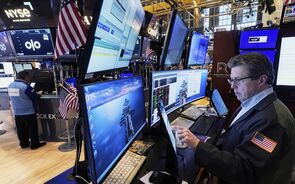Nichols, comentário para hoje e comentário ao FED.
1 Mensagem
|Página 1 de 1
Nichols, comentário para hoje e comentário ao FED.
A frase que penso que resume isto e que até bate certo com a hipotese do allen é: "If the market does manage to spark to life in another rally attempt, then it's likely to be an exhaustive trip that turns everybody bullish, which directly sets the stage for a much bigger decline. "
Fed Day
by David Nichols
I've been seeing a surprising amount of commentary from bullish writers and journalists that the Fed should leave interest rates unchanged, to demonstrate their faith in the budding economic recovery. This line of reasoning holds that such a move may cause initial unrest, but ultimately will spark a massive rally as widespread acceptance of "better days ahead" hits the mainstream.
All I can say to that is: Be careful what you wish for. If the Fed doesn't cut rates again, it could be the pin-prick for the credit bubble which has been supporting the entire modern financial edifice. And the Fed is highly aware of this fact.
If the flow of easy credit and easy money is choked off just a tiny little bit, then all sorts of bad things can happen to financial markets of every kind. The Fed doesn't want to even find out what that might look like -- until they have to, that is.
They've got to be sweating it right now. 12 rate cuts, and not even an uptick in capital spending, much less capacity utilization and job growth. Don't think they're not worried. They've even mapped out phase II of the battle plan, now that the ammunition from phase I (rate cuts) is running out and the enemy keeps advancing, undeterred. Fed Governor Ben Bernanke has publicly stated that the next step for the Fed is to wade into the open market with freshly printed dollar bills and start buying longer-dated Treasuries. This buying pressure would push up the price of bonds, keeping the yield at low levels. By the way, it was this policy indication from the Fed that directly led to the recent parabolic upside move in the bond markets, as investors piled in ahead of any such buying by the Fed.
So the next step in the Fed's master plan is to print U.S. dollars and then use them to scoop up U.S. debt. Think about that one for a second. In what conceivable way could that be construed as a sound, prudent thing to do?
This brings up a more subtle point about the Fed. Some day soon, institutional and individual investors are going to completely lose faith in Alan Greenspan and the Fed. The market has a looming Fed crisis to deal with. If there is no second half recovery this year -- yet again -- then the finger-pointing at the Fed is going to start in earnest. Already there is a low rumble.
Since this will be the 13th rate cut, it's a market event that traders are very familiar with at this point. The flurry of activity will start exactly at 2:15pm eastern time. If you're watching the market at that exact time, closely watch the instant, knee-jerk reaction from traders on the announcement. I'm talking about the first 20 seconds or so. The best market to watch is the "e-mini" S&P 500 futures, if you've got a live quote, but watching the Dow on CNBC will work too. These first ticks are usually the "tell" about which direction the bigger move is going to go.
Keep in mind this initial flurry is almost always wiped out instantly by a strong counter-move. And then there are so many jukes and jives it's hard to figure out anything. But keep an eye on that first flurry. It's a very pure sentiment reading from traders. It's a strong hint about the direction of the big trendy move that will start sometime over the next few days.
Yesterday was indeed what I call a "congestion" day, and we can see on the hourly chart of the SPX that the market is doing its typical thing, moving its hourly fractal dimension back up while congesting back to the 20-period moving average.

By 2:15pm, the market should be ready for action. Although there's no way to really know, I think there's a very good chance that investors are going to be disappointed with the actions from the Fed, no matter what happens. Sentiment has transformed to bullishness in the options markets that I've been watching closely intraday. The moves up to SPX 1007 and 1014 wiped out the zeal of the bears, and they haven't come back.
In other words, there aren't nearly as many bearish bets to get "blown out" at this point, which was the thing that was leading to those rapid spikes higher during the recent uptrend. And with the markets already having pulled back significantly from the highs, there isn't as much direct pressure on the few remaining bears to cover in a rush. This is a set-up for a "long squeeze", where the bullish majority gets tested by declining prices.
If the market does manage to spark to life in another rally attempt, then it's likely to be an exhaustive trip that turns everybody bullish, which directly sets the stage for a much bigger decline.

If the SPX can't get back over 1000, yet we see euphoric and enthusiastic acceptance of the rally and very little inclination to short it and buy puts, then we can look for a more dramatic selloff when that upside pressure is exhausted.
Sentiment Dashboard
by Adam Oliensis

SENTIMENT TANK: Filled 1.2 points to 1.5% full of negative sentiment. We're still seeing a high degree of complacency DESPITE the imminent Fed announcement.
SHORT-TERM: Remains in a decline phase, but it's weakening. The hourly gauge is ripe to have a go at an advance phase.
MID-TERM: Progressed a mere one point to 65% in its advance phase. Our Confidence Diffusion Index is on the wrong side of the ZERO line, however, at a bearish 2 (out of 7). The gauge has slowed to a virtual halt. It's hesitating. Mainly it's trying to measure moves on the tank too small and incremental to really be described as momentum.
LONG-TERM: No change from Monday. The weekly gauge remains at a neutral 94/6 with a bearish 2 on the CDI. The lean is still toward a decline phase but we don't have a signal yet.
BOTTOM LINE: Sentiment remains trapped in a quiet, complacent range. No breakout into a blowoff top and no spark of fear that would initiate a severe decline. Ordinarily uncertainty (fear) rises just before the Fed speaks. But the Greenspan et al have jawboned to such friendly effect that the only question is whether the Fed is extremely friendly, wildly friendly, or downright smitten with to the financial markets. (Does that define smugness or is it just a paradigm exemple of it? And how healthy can it be when market participants discount out the possibility of negative outcomes on subjects the outcome of which remain indeterminate?)
Fed Day
by David Nichols
I've been seeing a surprising amount of commentary from bullish writers and journalists that the Fed should leave interest rates unchanged, to demonstrate their faith in the budding economic recovery. This line of reasoning holds that such a move may cause initial unrest, but ultimately will spark a massive rally as widespread acceptance of "better days ahead" hits the mainstream.
All I can say to that is: Be careful what you wish for. If the Fed doesn't cut rates again, it could be the pin-prick for the credit bubble which has been supporting the entire modern financial edifice. And the Fed is highly aware of this fact.
If the flow of easy credit and easy money is choked off just a tiny little bit, then all sorts of bad things can happen to financial markets of every kind. The Fed doesn't want to even find out what that might look like -- until they have to, that is.
They've got to be sweating it right now. 12 rate cuts, and not even an uptick in capital spending, much less capacity utilization and job growth. Don't think they're not worried. They've even mapped out phase II of the battle plan, now that the ammunition from phase I (rate cuts) is running out and the enemy keeps advancing, undeterred. Fed Governor Ben Bernanke has publicly stated that the next step for the Fed is to wade into the open market with freshly printed dollar bills and start buying longer-dated Treasuries. This buying pressure would push up the price of bonds, keeping the yield at low levels. By the way, it was this policy indication from the Fed that directly led to the recent parabolic upside move in the bond markets, as investors piled in ahead of any such buying by the Fed.
So the next step in the Fed's master plan is to print U.S. dollars and then use them to scoop up U.S. debt. Think about that one for a second. In what conceivable way could that be construed as a sound, prudent thing to do?
This brings up a more subtle point about the Fed. Some day soon, institutional and individual investors are going to completely lose faith in Alan Greenspan and the Fed. The market has a looming Fed crisis to deal with. If there is no second half recovery this year -- yet again -- then the finger-pointing at the Fed is going to start in earnest. Already there is a low rumble.
Since this will be the 13th rate cut, it's a market event that traders are very familiar with at this point. The flurry of activity will start exactly at 2:15pm eastern time. If you're watching the market at that exact time, closely watch the instant, knee-jerk reaction from traders on the announcement. I'm talking about the first 20 seconds or so. The best market to watch is the "e-mini" S&P 500 futures, if you've got a live quote, but watching the Dow on CNBC will work too. These first ticks are usually the "tell" about which direction the bigger move is going to go.
Keep in mind this initial flurry is almost always wiped out instantly by a strong counter-move. And then there are so many jukes and jives it's hard to figure out anything. But keep an eye on that first flurry. It's a very pure sentiment reading from traders. It's a strong hint about the direction of the big trendy move that will start sometime over the next few days.
Yesterday was indeed what I call a "congestion" day, and we can see on the hourly chart of the SPX that the market is doing its typical thing, moving its hourly fractal dimension back up while congesting back to the 20-period moving average.

By 2:15pm, the market should be ready for action. Although there's no way to really know, I think there's a very good chance that investors are going to be disappointed with the actions from the Fed, no matter what happens. Sentiment has transformed to bullishness in the options markets that I've been watching closely intraday. The moves up to SPX 1007 and 1014 wiped out the zeal of the bears, and they haven't come back.
In other words, there aren't nearly as many bearish bets to get "blown out" at this point, which was the thing that was leading to those rapid spikes higher during the recent uptrend. And with the markets already having pulled back significantly from the highs, there isn't as much direct pressure on the few remaining bears to cover in a rush. This is a set-up for a "long squeeze", where the bullish majority gets tested by declining prices.
If the market does manage to spark to life in another rally attempt, then it's likely to be an exhaustive trip that turns everybody bullish, which directly sets the stage for a much bigger decline.

If the SPX can't get back over 1000, yet we see euphoric and enthusiastic acceptance of the rally and very little inclination to short it and buy puts, then we can look for a more dramatic selloff when that upside pressure is exhausted.
Sentiment Dashboard
by Adam Oliensis

SENTIMENT TANK: Filled 1.2 points to 1.5% full of negative sentiment. We're still seeing a high degree of complacency DESPITE the imminent Fed announcement.
SHORT-TERM: Remains in a decline phase, but it's weakening. The hourly gauge is ripe to have a go at an advance phase.
MID-TERM: Progressed a mere one point to 65% in its advance phase. Our Confidence Diffusion Index is on the wrong side of the ZERO line, however, at a bearish 2 (out of 7). The gauge has slowed to a virtual halt. It's hesitating. Mainly it's trying to measure moves on the tank too small and incremental to really be described as momentum.
LONG-TERM: No change from Monday. The weekly gauge remains at a neutral 94/6 with a bearish 2 on the CDI. The lean is still toward a decline phase but we don't have a signal yet.
BOTTOM LINE: Sentiment remains trapped in a quiet, complacent range. No breakout into a blowoff top and no spark of fear that would initiate a severe decline. Ordinarily uncertainty (fear) rises just before the Fed speaks. But the Greenspan et al have jawboned to such friendly effect that the only question is whether the Fed is extremely friendly, wildly friendly, or downright smitten with to the financial markets. (Does that define smugness or is it just a paradigm exemple of it? And how healthy can it be when market participants discount out the possibility of negative outcomes on subjects the outcome of which remain indeterminate?)
1 Mensagem
|Página 1 de 1



